I have always wanted to try Apple HomeKit out. While I did’t want to spend ridiculous amount of money to just find out I have decided to build this on my own as see.
I had RaspberryPi 3 in home without any purpose. Originaly I bought this computer for learning in electronics and programming. I did some basic stuffs like controling LEDs, LCD etc. and then I bought Arduino for my projects. So it was the right time to get a life to this little guy.
Continue reading “Control LED with Siri on RaspberryPi via Apple HomeKit”

